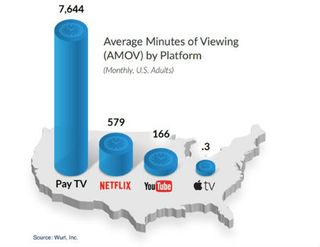Wurl Releases Video Viewing Index

Mobile and over-the-top platforms are cutting into overall video usage patterns, but traditional pay TV still leads the way – by a big margin.
That’s according to streaming video platform vendor Wurl, which introduced a U.S.-focused index called AMOV (an acronym for Average Minutes of Viewing) that quantifies results based on a mix of public sources, including Nielsen, the NCTA, Pew Research, media reports and the OTT platform and service providers themselves.
The index takes into account both usage (minutes of viewing) and reach (percentage of U.S. adults that use the service) and outlines how it arrived at its findings.
As the first report shows (Wurl intends to offer quarterly updates), the monthly pay TV AMOV was 7,644 minutes, followed by Netflix (579 minutes), MVPD-provided guides (396 minutes), YouTube (166 minutes), video via mobile (78 minutes), Roku (0.7 minutes) and the Apple TV (0.3 minutes).
Sean Doherty, CEO and co-Founder of Wurl, said the report aims to bring more context around the usage of these various platforms, noting that content providers need to get a better sense of how they are being used by consumers beyond data such as shipment figures.
“We got tired of hearing about big numbers…we were wondering about usage,” Doherty said, noting that while smartphones are seeing usage climb, apps usage on smart TVs are “very low” despite having a huge installed base.
He also allows that the numbers will skew differently when viewed through a demographic lens, noting that usage among millennials will be much higher on mobile and OTT platforms than on pay TV.
Multichannel Newsletter
The smarter way to stay on top of the multichannel video marketplace. Sign up below.
He said Wurl also hopes that the report will flush some OTT suppliers out of the pocket and cause them to be more transparent about their data, but acknowledged that Wurl’s report “erred on the side of being generous on each of these platforms,” based on the data the company could locate and interpret.
The usage data, he said, shows that IP-connected set-top boxes from MVPDs such as Comcast, DirecTV and Dish Network provide the best way to blend traditional video services with OTT.
MVPDs, he said, have the potential to be the leader if they act quickly because they still have the usage advantage. If they don’t, consumers will continue to gravitate to other platforms like Roku and the Apple TV.
Some are moving faster than others. Dish does offer Netflix on its Hopper platform, Comcast is expected to bring an OTT service called Watchable to X1, and TiVo has built a platform that blends TV with OTT. WideOpenWest, meanwhile, is also integrating OTT on an Arris system that uses Wurl’s technology.
MVPDs have time to adjust, but the window is closing, Doherty said, noting that Wurl has other MVPD-facing deals in the works. Some include tighter integrations whereby “you don’t know what’s a streaming channel and what’s a linear channel.”
